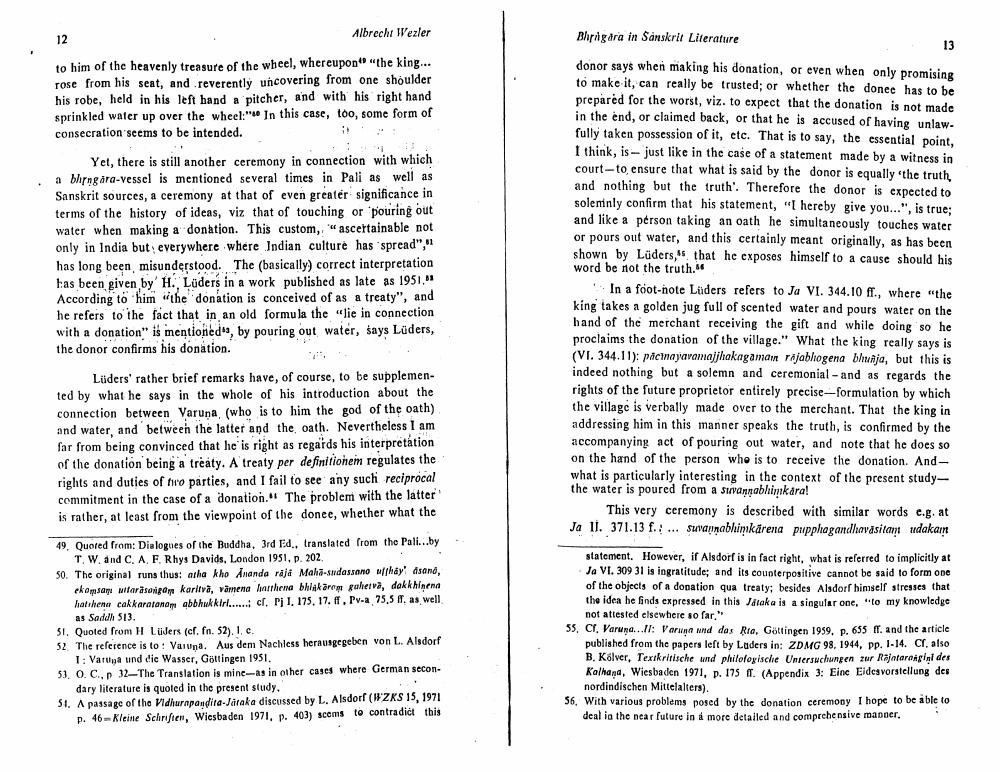Book Title: Bhrngara In Sanskrit Literature Author(s): A Wezler Publisher: A Wezler View full book textPage 7
________________ Albrecht Wezler Bhrigara in Sanskrit Literature to him of the heavenly treasure of the wheel, whereupon the king... rose from his seat, and reverently uncovering from one shoulder his robe, held in his left hand a pitcher, and with his right hand sprinkled water up over the wheel:" In this case, too, some form of consecration seems to be intended. i ' . Yet, there is still another ceremony in connection with which a bhrngara-vessel is mentioned several times in Pali as well as Sanskrit sources, a ceremony at that of even greater significance in terms of the history of ideas, viz that of touching or pouring out water when making a donation. This custom, ascertainable not only in India but everywhere where Indian culture has spread"," has long been misunderstood. The (basically correct interpretation has been given by H. Lüders in a work published as late as 1951," According to him the donation is conceived of as a treaty", and he refers to the fact that in an old formula the "lie in connection with a donation" is mentioned", by pouring out water, says Lüders, the donor confirms his donation. donor says when making his donation, or even when only promising to make it, can really be trusted; or whether the donce has to be prepared for the worst, viz. to expect that the donation is not made in the end, or claimed back, or that he is accused of having unlaw. fully taken possession of it, etc. That is to say, the essential point, I think, is just like in the case of a statement made by a witness in court-to ensure that what is said by the donor is equally the truth and nothing but the truth'. Therefore the donor is expected to solemnly confirm that his statement, "I hereby give you...", is true; and like a person taking an oath he simultaneously touches water or pours out water, and this certainly meant originally, as has been shown by Lüders," that he exposes himself to a cause should his word be not the truth." In a foot-note Luders refers to Ja VI. 344.10 ff., where the king takes a golden jug full of scented water and pours water on the band of the merchant receiving the gift and while doing so he proclaims the donation of the village." What the king really says is (VI. 344.11): pacinayaramaljhakagaman rajablogena bhuaja, but this is indeed nothing but a solemn and ceremonial - and as regards the rights of the future proprietor entirely precise--formulation by which the village is verbally made over to the merchant. That the king in addressing him in this manner speaks the truth, is confirmed by the accompanying act of pouring out water, and note that he does so on the hand of the person who is to receive the donation. Andwhat is particularly interesting in the context of the present studythe water is poured from a suvannabhinkara! This very ceremony is described with similar words c.g. at Ja 11. 371.13 f... Suvarnabhimkarena pupplagandhavasitam udakam Lüders' rather brief remarks have, of course, to be supplemented by what he says in the whole of his introduction about the connection between Varuna, (who is to him the god of the oath) and water, and between the latter and the oath. Nevertheless I am far from being convinced that he is right as regards his interpretation of the donation being a treaty. A treaty per definitionein regulates the rights and duties of the parties, and I fail to see any such reciprocal commitment in the case of a donation. The problem with the latter is rather, at least from the viewpoint of the donce, whether what the 49, Quered from: Dialogues of the Buddha, 3rd Ed., translated from the Pali...by T. W. and C. AF. Rhys Davids, London 1951, p. 202 50. The original runs thus: arha kho Ananda raja Mala-sadassano withay dsand, ekomsam witarasancom karliva, vamena lanthena bhlikarom galeiva, dekkhinena hathena cakkaratanm abbhuk kiri....... cl. 1. 175. 17. f. Pv-a 75,5 IT, as well as Saddl 513. 51. Quoted from H Lüders (cf. fn. 52). I, c. 52 The reference is to : Varuna, Aus dem Nachless herausgegeben von L. Alsdorf 1: Varta und die Wasser, Göttingen 1951. 53, 0. C. 32-The Translation is minc-as in other cases where German secon dary literature is quoted in the present study. Si. A passage of the Vidhurnpandita-Järaka discussed by L. Alsdorf (WZKS 15, 1971 p. 46- Kleine Schriften, Wiesbaden 1971. D. 403) scems to contradict this statement. However, if Alsdorf is in fact right, what is referred to implicitly at JA VI. 309 31 is ingratitude; and its counterpositive cannot be said to form one of the objects of a donation qua treaty; besides Alsdorf himself stresses that the idea he finds expressed in this Jataka is a singular one, "to my knowledge not attested elsewhere so far." 55. Cr. Varuna...: Varinn und das Rra, Göttingen 1959, p. 655 ff. and the article published from the papers left by Laders in: ZDMG 98, 1944, pp. 1-14. Cl. also B. Kolver, Textkritische und philologische Untersuchungen zur Rajataraisial des Kalhand, Wiesbaden 1971, p. 175 fr. (Appendix 3: Eine Eides vorstellung des nordindischen Mittelalters). 56. With various problems posed by the donation ceremony I hope to be able to deal in the near future in a more detailed and comprehensive manner.Page Navigation
1 ... 5 6 7 8 9 10 11 12 13 14 15 16 17 18 19 20 21 22 23
